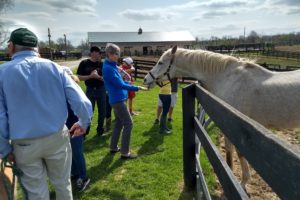While reading through brochures published by the National Park Service, I realized that I really didn’t know the whole story of wagon trains going to the west coast so I thought we’d spend some time looking at what I hadn’t known.

The itch to go west started in the 1700s as the nation grew. After Lewis and Clark found a way to the Pacific in 1805, fur traders followed Indian trails through river valleys and over mountain passes, filling in blank spaces on early maps. By the late 1830s, mountain men had explored most of the routes that became overland trails. An economic panic swept across the nation in 1837 prompting more people to try something new. Throughout the 1840s promoters and trail guides promised fortunes and better health to those who would journey to California. The concept of Manifest Destiny in 1845 described the government’s thirst for expansion.
early emigrants (only California through the Sierras)
1841 – The first to go to California, the Bidwell-Bartleston party, left Missouri in May with 69 people. Some split off for Oregon, but 39 made it to California in November. Of this group, 5 were women, and about 10 were children.
1844 – the Stephens-Townsend-Murphy party traveled the Truckee route (rather than going to Carson Valley) and reached the Sierra Nevada in November. Because of snow, they left their wagons at Donner lake and continued walking. In the spring, they came back for their wagons and supplies and made it all the way to Sutter’s Fort, the first emigrants to take their wagons all the way there.
1845 – John C. Fremont explored a new route across the Great Basin.
1845 – the next summer a promoter, Lansford W. Hastings, talked a late-starting party of 80 wagons to try a new cutoff across the Great Salt Lake Desert, resulting in disaster for the Donner-Reed party. Nearly half the party died of cold and starvation around Donner Lake while staying in makeshift shelters.
1848 – Mormon Battalion veterans, after fighting during the war with Mexico, left Sutter’s Fort for Salt Lake City. They opened a wagon road over Carson Pass, south of Lake Tahoe and ended up south of the Mormon Station in Carson Valley, that became the route for gold rush travel. (Abner Blackburn had been part of this battalion and saw the richness of Carson Valley where he wanted to put his trading station.)
1848 – Gold was discovered on January 24 at Sutter’s Mill; in December President Polk confirmed the discovery to Congress, setting the stage for the largest voluntary migration in American history.
1849 – By spring, gold fever was an epidemic. Thousands of “forty-niners” clogged the trail, trail herds ate up the grasslands, overcrowded campsites and unsanitary conditions led to spread of cholera. Tension grew as Indians saw plants and animals they depended on for food disappear. Many new trails opened up to California.
Most of the various trails starting out on the Missouri River started merging to follow the Oregon Trail along the Platte and North Platte Rivers.
1852 – About a third of those crossing the plains were women. Within 5 years, wagon parties were largely made up of women and their children hoping to find a better life. We wondered why so many women went west without husbands. One guess is that so many single men and husbands went west at the beginning of the gold rush, and perhaps the wagon trains less than 10 years later are the wives and families of those men. The Comstock Lode had happened at the end of the decade in Nevada so that strike wasn’t a draw for these women. What do you think?
1860 – Freight and mail companies, the military, new settlements and trading stations, and thousands of travelers going both ways transformed the California Trail into a road.
Indians and the emigrants
1840s – Fatal confrontations were rare. Indians served as scouts for the travelers across swift rivers and through unfamiliar country.
1844 – Paiute Chief Truckee guided travelers along the route and river later named for him.
1845 – Paiute Sarah Winnemucca recalled they would have helped the Donner-Reed party but they were afraid of them
1850s to 1860s – Conflict increased as emigrants and their livestock destroyed Indian food sources. Some Indians wanted payment for passage across tribal lands but few paid. Relations deteriorated, and death happened on both sides. But . . . most emigrant deaths came from drownings, accidents, and disease (especially cholera). Many incidents were the work of criminals called “white Indians,” notorious for their brutality as they followed the wagon trains.
1869 – railroad was completed, connecting the east coast with the west coast and signaling the end of the wagon trains.
other tidbits
early technology – When going over the mountains, often the wagons would be taken apart and hauled up piece by piece. The wheels were at the top of the mountain to be used as a pulley system.
circling the wagons – used to corral livestock as well as create community
life on the trail – travelers would often stop for an extra day to have a picnic or just enjoy the grandeur around them




